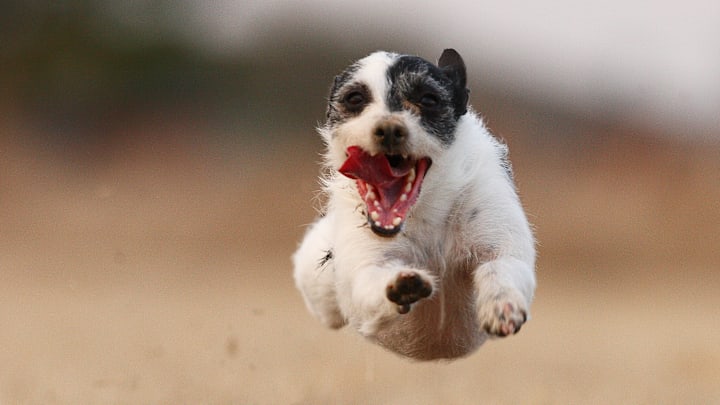Watching your pet run after a car is something that can make your heart skip a beat. Not only is it tiresome and frustrating to manage, it’s also downright dangerous for dogs and their handlers. Before you start training your dog to stop chasing cars, it’s important to understand what drives the behavior.
Why Dogs Chase Cars
Bolting after a high-speed vehicle seems like a bad idea to humans, but the situation is different from a dog’s perspective. “Chasing is an instinctive behavior for dogs,” Samantha Mountain, a professional dog trainer at Monkey Business Dog Training in Montreal, Canada, tells Mental Floss. Your pup isn’t trying to misbehave—it’s simply doing what dogs are naturally inclined to do.
“A dog that chases has what is called a ‘predatory instinct,’” Mountain says. “There are stages that define the instinct: see, orient, stalk, chase, grab bite, and kill bite.” Movement, particularly anything that moves past a dog at a high speed, will trigger that predatory instinct. But even if your pet stops at chase and doesn’t try to bite and kill an oncoming vehicle, it’s still crucial to nip that behavior in the bud.
Any dog can have a high predatory instinct, but some are more prone to chasing than others. Breed has a lot to do with it; as Mountain explains, terriers and border collies—which were originally meant to hunt and herd—have a strong chase instinct.
How to Stop Your Dog from Chasing Cars
There are some training methods that work to curb this dangerous behavior. But before you start a training routine, ensure your dog is getting enough exercise. “A dog that doesn’t have its daily exercise needs met may have extra energy to burn, so they might chase,” Mountain says.
Start in your home or your backyard, in places where there aren’t any triggers. Then, you can slowly expose your dog to more moving objects, people, or cars. Stay away from busy streets, and stick to quieter places with fewer distractions.
It’s important to keep your dog on a leash when out for a walk, and be sure to stick with positive reinforcement methods such as praise and treats—punishment may suppress the behavior for a time, but makes it more likely your dog will continue chasing cars in the long run.
Use training methods that give you the control you need to stop the dog’s urge quickly. “The most important focus should be on impulse control,” Mountain explains. She suggests recall training, which uses a command (or in some cases, a clicker) to signal to your dog. If you make the signal as soon as your dog is exposed to a trigger such as a car it wants to chase, it will return to you instead of going after the car.
“You could also try using the verbal cues ‘leave it’ and ‘watch me,’” Mountain says. With the cue “leave it,” you expect your dog to leave whatever it is that has its attention and return to you; with “watch me,” you’re directing your dog to immediately look and turn to you.
If you find your pet isn’t responding well to the training, contact a professional. With careful training and behavior management, you can avoid the stress and worry brought on by a dog who loves the thrill of the chase.
